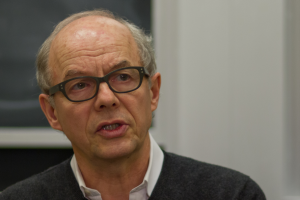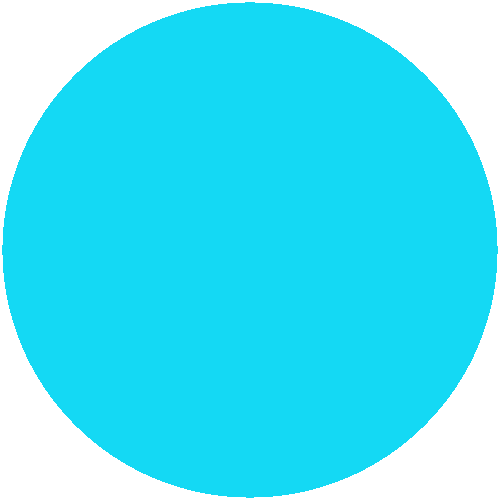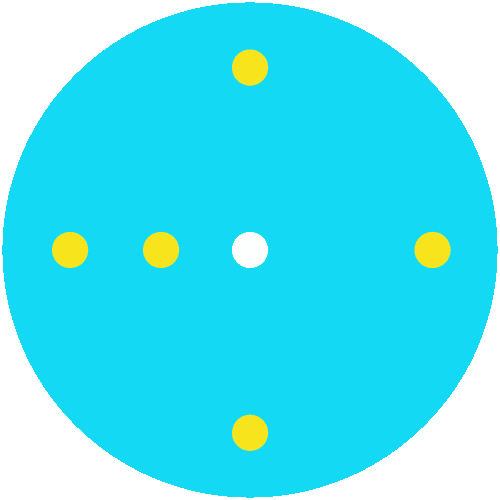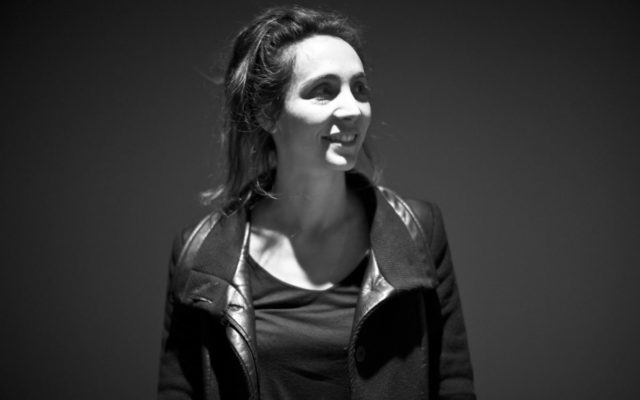This was a great initiative from the NFB and ARTE… A call for interactive projects with a strong ambition : how to imagine a sort of « web equivalent » to traditional japanese haikus ? 162 proposals from 20 different country have been received by the jury. 12 were chosen to be concretized, and have recently been published here. William Uricchio, author, professor of Comparative Media Studies and Lead Principal Investigator at the MIT Open Documentary Lab, was the chairman of the jury. Interview.
 Le Blog documentaire : How was this jury experience ? Was it hard to choose ? Were there any battle between the jury members ?
Le Blog documentaire : How was this jury experience ? Was it hard to choose ? Were there any battle between the jury members ?
 William Uricchio : The jury experience was wonderful ! What could be better than discussing possible interactive haikus with a team made up of leading makers, curators, producers and thinkers of interactive forms ? Everyone was passionate, represented their perspectives well, and listened to what others had to say. I very much appreciate learning to see from other points of view, and personally, I can say that I came away richer for the experience.
William Uricchio : The jury experience was wonderful ! What could be better than discussing possible interactive haikus with a team made up of leading makers, curators, producers and thinkers of interactive forms ? Everyone was passionate, represented their perspectives well, and listened to what others had to say. I very much appreciate learning to see from other points of view, and personally, I can say that I came away richer for the experience.
[The other jury members were Alexander Knetig, Caspar Sonnen, David Carzon, Hector Ayuso, Jonathan Harris and Marie-Pier Gautiher]
What criteria have seduced you ? What were the small details that made the difference ?
Keeping the spirit of haiku in mind, I was most attracted by the fit between form and function, a fit that I expected to be elegant in its simplicity and power, just as great haikus are. Haiku is all about the detail, but the detail only makes sense relative to a larger whole. Many details add up to make the whole, and at the same time, each can reveal the whole. The details show up in things like how the interface is imagined and realized – take for example Z’s use of the zipper to reveal the infinity of ‘layers’ on our computer screens, a metaphor many of us probably share, but one not always evident in our normal interfaces. Elegant, concise… effective.
Was there any kind of dialogue between the jury and the authors ? Which kind of support have they received during the realization of the different haikus ?
None that I’m aware of ! Once we selected our finalists, our job as a jury was done. It could well be that as individuals, members of the jury consulted with various authors – it’s a small world !
Do you know if the projects were simple to produce ? Do you follow the different process ?
One of the great things about having such a remarkable range of expertise represented on the jury was that we could quickly assess the scope of the proposals. Could technological plans actually be realized (on time and within budget) ? Did the teams proposing particularly challenging projects have any previous experience with the tools or design ideas they were proposing ? While this wasn’t our main criterion (after all, one always wants to be surprised by novel solutions to problems !!!), I’d say that we had a pretty good sense of whether projects would be easy or difficult or even possible to complete. As with the previous question, the jury’s work officially ended with its naming of the finalists ; but it’s such a small community that many of us run into one another on a regular basis.

Today, how do you judge the possible gap between the projects on the paper and the haikus concretized ?
Good question ! I think the two main ways that we tried to assess the gap between concept and concretization were 1) understanding the technical feasibility of projects – were they using established tools or techniques ? Bending existing technologies in possible ways ? Inventing an alternative to the wheel ? And 2) having a sense of the track record of the relevant team members – did they have any experience with the ideas or techniques they were proposing ? Were they in a position to assess realistically what they were proposing ?
Now that I’ve seen and worked with the various haikus, I’m delighted to say that in almost every case I’ve been surprised, moved even, by the results. I realize that my thinking about the projects during the judging phase was just that… ‘thinking’. The questions and insights were, I think, realistic. But seeing and working with the sounds, images and interfaces of the various projects was (and is !!! I find myself going back to the NFB Haiku site regularly !!) magical !
Has the jury sought a certain form of unity among the 12 projects elected ? Or do you feel a general meaning emerge from the different proposals ?
My impression is that, although there was some amount of overlap in the projects that we as individuals brought to the first jury meeting, there were also important differences. We spent quite a bit of time discussing each project, and it’s fair to say that a robust sense of consensus emerged by the end. The process really benefitted by having a group of people who are experts in their various domains, and who came armed with strong opinions, and I for one learned a lot in the process !
As for a general meaning in the projects… for me, there is a general ‘modality’ : a playfulness, a reflexivity, a provocation to question the surface of things and first impressions. One is tempted to glibly invoke ‘the meaning of life’… or not so glibly, since so many of the classic literary haiku do precisely that, through a refraction of insight from the play of poetic images. And in a sense, the same is true here, as well. The simple has an uncanny knack for becoming profound, and its this penchant more than any ‘meaning’ that to me unifies the projects.
More generally… 5 out of 12 projects come from France, 3 from Canadia… What’s your point of vue on interactive webproductions around the world today ? And do you think a “French touch” exist ?
There must be something in the water ! Yes, by far the majority of the initial applications were French and Canadian, as were the selected projects. And judging by the wonderful work of the NFB, Upian, ARTE, and many others, it does seem like the French cultural contributions to these new developments are disproportionately significant. Speculation about culture is always a dangerous thing, but I’ll venture two possibilities : first, the French language seems to do best when deployed with a certain ‘playfulness’ (multiple layers, reflexivity, etc.) ; and second, as cinema showed right from the start (Cohl, Méliès and even in their own way, the Lumière Brothers), experimentation was culturally valued, celebrated and provided a base for new artistic visions. This cannot be said about all languages and cultures….
How do you consider the evolutions that has impacted digital storytelling and webdocumentary experiences for 10 years now ?
I’d say that there are a couple of important developments :
- First, public participation rates have never been so high : Youtube is currently uploading something like 400 hours of material per minute.
- Second, as storytelling tools and platforms enter that magical space where they not only get better but are often free, we are seeing more and more people take up interactive storytelling, and explore its possibilities — a wider range of voices is now speaking, telling stories, sharing experience. This holds as much for diversity within the developed world, as it does for global reach.
- Third, as newspapers and broadcasting organizations shift from an ‘old wine in new bottles’ approach to putting things on the internet and mobile, they too are exploring the potentials of digital-first forms of storytelling — and providing outlets and new audiences for some first-rate interactive work ! The NFB has been a thought leader here !
- And finally (fourth), we are just beginning to see some very exciting advances in algorithmic storytelling… Applications that enable high levels of customization (responsive personalization, if you like) and apparent linearity, without any need for the user to actively navigate. In other words, a sit back experience with all the affordances of lean-forward interactivity.

Do you think that images and sounds are equally treated today in these works ?
Well, this batch of haikus has some great examples of what’s possible. Cat’s Cradle, for example, morphed from a visual tool to an acoustical instrument after about ten minutes of use – at least for me ! Music in the Key of Life revealed a hidden symphony in the everyday things that clutter our lives… Sound was an important criterion in our judging process, and I think the haiku projects generally make good use of it.
There’s a larger issue here… As a culture, we tend to be word-centric, being quite adept at using words to talk about other words. We can use words to talk about images, but that seems more difficult… and using words for sound has a very long way to go. Sure, we can talk with ease about music, but sound is both fairly abstract and subjective. All to say that sometimes, good and creative uses of sound are there, but simply not as well discussed by critics as word or image. I’m inspired and heartened by the great interactive work coming out of radio ; and I think most visual interaction designers realize the importance of sound in for platforms like the mobile or tablet or computer screen, low on visual information but armed with immersive acoustical potential.
Since The Cancer of Time, animation and graphical elements seem to play a more and more important role. How do you evaluate that phenomenom ?
Animation has always been about control, planning… producing 16-24 frames for each second of screen time. It doesn’t have the privilege of 50:1 or 100:1 shooting ratios, of the ‘let’s figure it out in the cutting room’ mentality. So in this sense, it shares something basic with interactivity as well, which also requires meticulous planning. But there is a second reason that I think has to do with screen size. Mobile continues to grow in popularity, eroding ‘time spent’ on computer screens, which of course eroded ‘time spent’ on traditional platforms like television and print. I’m not sure if it’s ever been possible to satisfy all screen sizes with one set of images, from the cinema down to the mobile ; but it seems that others are beginning to come to the same realization. Animation and graphical elements offer the potential of great clarity of purpose. Rather than focusing in on important information in the world, filtering away the noise and trying to make it stand out, as photography so often does, animation creates that important visual information from scratch, seeking the most effective way to express it. This can be a huge advantage for certain kinds of tasks.

Don’t you think that the forms of the projects remain a bit more important that the intellectual background ? In theses haikus and in web documentary experiences in general ?
Well, I suppose it’s true that the haiku, like documentaries, are ultimately judged by most audiences on the basis of whether or not they work. How they resonate with the literary structure of the haiku, or the manifesto of a particular documentary maker, only seems to matter in the second or third analysis (and even then, perhaps only to certain people like critics, academics, etc.). So yes, I’d agree that the forms of the projects are ‘a bit more important’…if people don’t like something, it will tend to disappear. But that said, I think it’s also important to take into consideration what haiku’s and documentaries seek to accomplish, to understand the traditions they are part of or breaking from, to even have a sense of their technologies and possibilities. Yes, of course we want people to be engaged with a particular project ; but informed engagement leads to appreciation, encourages a critical stance, helps with the work of judgment.
What about virtual reality experiences ? Is it the future for digital documentary storytelling, or just a tendancy that will quickly disappear ?
VR is a tool, and it enables some things at the same time that it has a price. At least in this headset-dominated moment of VR, one of the huge prices is the collective viewing experience. True, the nature of collective experience is changing in the mobile age, but it remains an important element of the social character of certain media forms. VR is a tool that is terrific as an antidote to the every more reduced screen experience ; terrific with helping to capture or express certain kinds of information and interaction. Karim Ben Khelifa’s The Enemy would be a great example of what’s possible. But it is by no means a ‘one-size-fits-all’ sort of tool, and I suspect that our use of these technologies will drive a wedge between ‘presence’ and ‘story’… something that very much echoes what scholars of early cinema call the ‘cinema of attractions’ vs the ‘cinema of narrative integration’. As such, while terrific for sensation, presence and the shocks of ‘attraction’ that Sergi Eisenstein discussed, they may not make the most compelling story tools.
The history of immersive technologies teaches us that no matter how sensational and convincing the latest, greatest system feels… wait a few years, and the magic will wear off as yet another contender enters the scene. I’d also say that contemporary ‘stageless’ forms of performance are doing a magnificent job of taking ‘reality’ as we experience it and working with it as creative matter. I have far greater expectations for this type of work, which literally intervenes in our being in the world (especially in a documentary sense, where it can force our noses up against reality), than I do for the promise of ever-more realistic, technologized simulations. I guess you could say I’m a brechtian in these matters, and of course VR can be deployed in a critical, consciousness-raising manner (again, The Enemy), but the discourse of VR seems too often veers towards the immersive and transparent.
Which project seduce you most recently ? (And which haiku do you prefer ?)
😉
Do you have any “interactive dream” ?
Hmmm… two kinds : the first are the kind I often have while sleeping. Dreams often seem to be the most immersive (even in VR sense !) — and still highly interactive — stories that I experience on a regular basis. I’m still trying to pin down the authorship issues, but that’s another story !
The second relates to algorithmic storytelling, which seems like it will enable a scenario in which, even though what we experience will feel like a seamless linear narrative, it will in fact be constructed on the fly and uniquely for ‘me’ from a database of possibilities. In other words, the interactivity that is today so visible to us as we click, scroll and even gesture our way through a narrative ecosystem, may fade into the background as an algorithm anticipates many of the same choices. This keeps the choices (and ultimately the story) highly personalized and interactive, while rendering the form and experience more linear. This sort of system could in theory be used to help us see the story world through eyes other than our own (just as it could be used to fulfil an egomaniac’s dream !) ; and it could be responsive to various sorts of feedback (including voice and biofeedback). As usual with these affairs, when things go badly, don’t blame the tool, blame the user !
Interview by Cédric Mal




